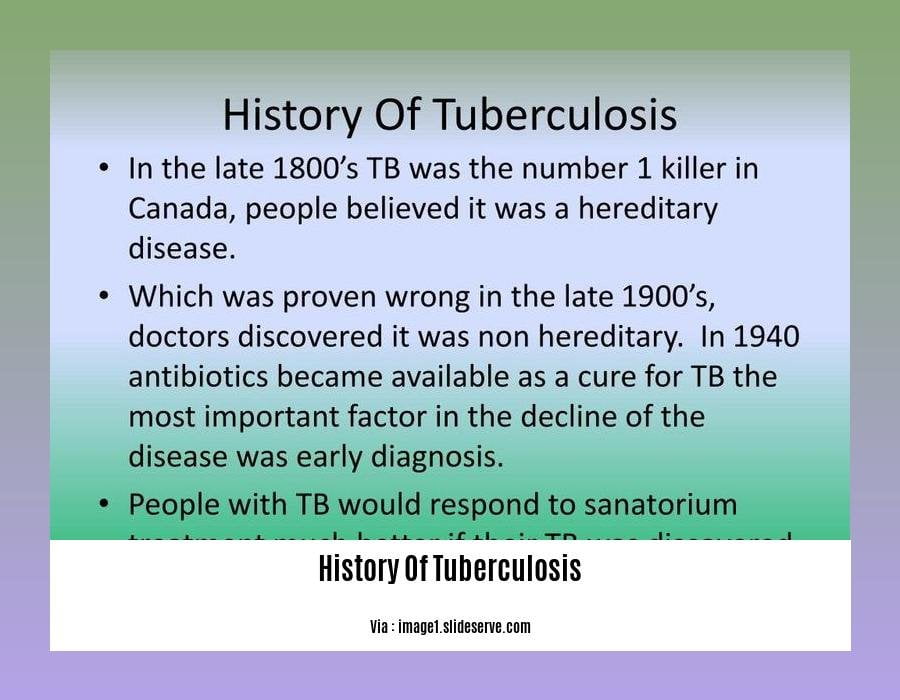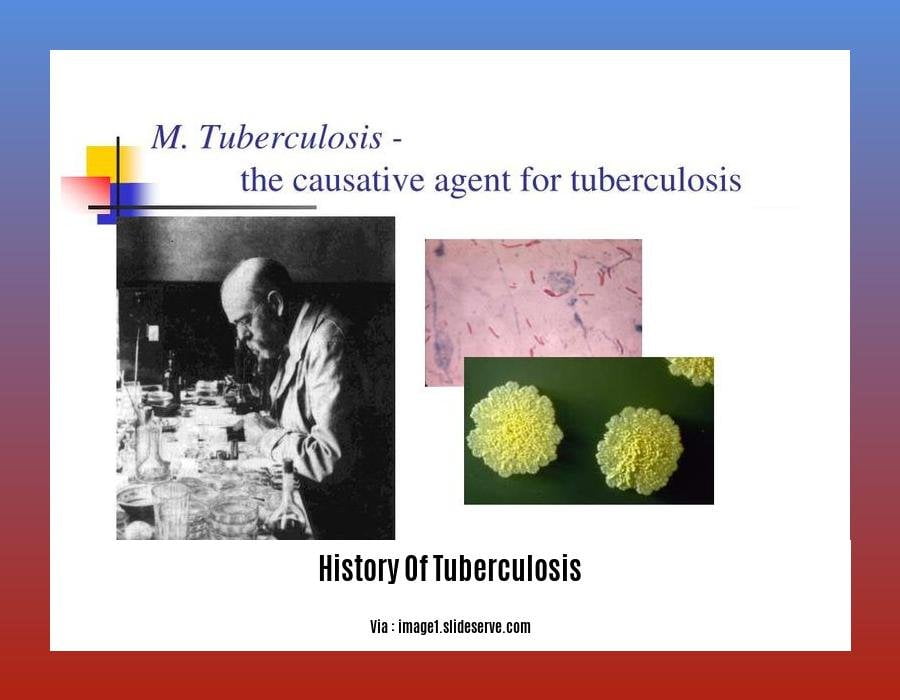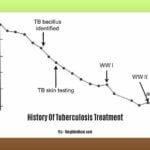[- The History of Tuberculosis: An Exploration of a Disease That Has Shaped Societies for Centuries -] Delve into the captivating history of tuberculosis, a disease that has left an indelible mark on societies across the globe. From its ancient origins to the present day, tuberculosis has shaped medical practices, public health policies, and social attitudes towards illness. Discover the remarkable stories of resilience, innovation, and the unwavering pursuit of a cure as we journey through the annals of this persistent disease.
Key Takeaways:
- Tuberculosis (TB) is an infectious disease caused by Mycobacterium tuberculosis (MT).
- TB has been around for centuries, affecting societies throughout history.
- Evidence suggests that TB coexisted with humans in ancient civilizations, such as the Neolithic period in the eastern Mediterranean.
- In pre-Columbian America, TB was present, as indicated by archaeological findings and studies of ancient remains.
- During the Middle Ages and Renaissance in Europe, TB was widespread and associated with poverty and overcrowding.
- In the 17th and 18th centuries, TB was known as consumption due to its wasting effect on the body.
- In 1882, Dr. Robert Koch discovered Mycobacterium tuberculosis, the bacteria that causes TB.
- Development of the BCG vaccine and effective treatments, including antibiotics and multi-drug therapy, have made significant strides in combating TB.
- TB remains a global health concern, with ongoing efforts to develop new vaccines, diagnostics, and treatments to control and eliminate the disease.
History of Tuberculosis: Unraveling the Story of a Global Adversary


The history of tuberculosis (TB), a communicable disease, stretches across centuries, leaving a deep imprint on human societies. Its impact extends beyond mere physical health; it has shaped medical practices, public health policies, and societal attitudes towards illness. As we journey through time, let’s unravel this intricate tale of a disease that has left an undeniable mark on humanity.
Ancient Origins and Early Civilizations
Our earliest evidence of TB’s presence dates back to Neolithic human settlements in the eastern Mediterranean. Skeletal remains reveal traces of the insidious Mycobacterium tuberculosis, the causative agent of this devastating disease. As civilizations blossomed and trade routes expanded, TB spread its reach, becoming a global companion to humanity.
The Scourge of Europe: Middle Ages and Renaissance
During the Middle Ages and Renaissance, TB flourished in the overcrowded and unsanitary conditions that defined Europe’s urban centers. Associated with poverty and squalor, it earned the dreaded moniker ‘consumption,’ epitomizing the gradual wasting away of its victims. Tuberculosis became a pervasive threat, claiming countless lives.
Pre-Columbian America: A Tale of Resilience
In pre-Columbian America, TB’s presence was undeniable, woven into the fabric of ancient societies. Archaeological evidence and studies of preserved remains paint a picture of a disease that coexisted with Native American populations. Yet, it was the arrival of European colonizers, bringing with them their own strains of TB, that dramatically reshaped the epidemiology of the disease in the Americas.
The Dawn of Understanding: 19th Century Breakthroughs
The 19th century marked a turning point in our understanding of TB. In 1882, Dr. Robert Koch, a German physician, unveiled the causative agent of TB: Mycobacterium tuberculosis. This groundbreaking discovery opened the door to targeted research and the development of effective treatments.
Vaccines and Treatments: Progress in the 20th Century
The 20th century witnessed significant advancements in the fight against TB. The development of the Bacillus Calmette-Guerin (BCG) vaccine in the early 1900s marked a critical step in preventing infection. Effective antibiotic therapies, particularly multi-drug therapy, emerged as potent weapons against the TB bacillus. These breakthroughs offered renewed hope in the battle against this ancient scourge.
Contemporary Era: Challenges and Hope
Despite remarkable strides, TB persists as a global health concern, with millions of cases reported annually. The emergence of drug-resistant strains presents a formidable challenge, demanding innovative strategies and intensified efforts. Yet, amidst these hurdles, hope remains. Ongoing research into new vaccines, diagnostics, and treatments holds the promise of a TB-free future.
The intriguing history of Tuberculosis ICD 10 offers insights into the classification and diagnosis of TB throughout history.
Delve into the history of Tuberculosis treatment to discover the evolution of therapies and advancements in combating the disease.
Explore the history of Tuberculosis in the United States, uncovering the impact and efforts to control its spread within the nation.
Discover the milestones and challenges in the history of Tuberculosis vaccine, shedding light on the quest for prevention.
Uncover the fascinating history of Tuberculosis in Africa, examining the unique challenges and efforts in addressing the disease on the continent.
Tuberculosis Treatment: Evolving Approaches Throughout History
Tuberculosis, an infectious disease with a rich history, has been shaping medical practices and public health policies for centuries. Its impact on societies has been profound, leading to the development of various treatments over time. Join us as we delve into the evolution of tuberculosis treatment and its significance in tackling this persistent disease.
Key Takeaways:
- Tuberculosis treatment has undergone significant advancements, from ancient remedies to modern antibiotics and vaccines.
- Treatment and prevention strategies have evolved according to medical understanding and technological progress.
- Collaboration between healthcare professionals, researchers, and public health organizations has been crucial in developing effective tuberculosis treatment methods.
A Journey Through Time: Tracing Tuberculosis Treatment
Ancient Remedies and Rituals: In ancient civilizations, tuberculosis treatment often involved spiritual rituals, herbal remedies, and traditional healing practices. Isolation of infected individuals was also practiced.
Early Medical Approaches: Greek physician Hippocrates described tuberculosis as a curable disease and advocated rest, fresh air, and a nutritious diet. Later, Galen introduced bloodletting and purging as treatments.
Advances in the 19th Century: The discovery of the tuberculosis bacillus by Robert Koch in 1882 marked a turning point. Sanatoriums were established to provide specialized care and isolation for patients. Fresh air, sunlight, and rest were emphasized as therapeutic approaches.
The Antibiotic Era: The introduction of antibiotics in the 20th century revolutionized tuberculosis treatment. Streptomycin, the first effective antibiotic against tuberculosis, was discovered in 1943. Multi-drug therapy emerged, combining multiple antibiotics to enhance efficacy and prevent resistance.
Continued Research and Development: Ongoing research focuses on developing new antibiotics with improved effectiveness and reduced side effects. Novel vaccines are also being explored to prevent tuberculosis infection and disease progression.
The Road Ahead: Collaboration and Innovation
The fight against tuberculosis continues, with a renewed emphasis on collaboration and innovation. Public health programs, international organizations, and research institutions work together to improve tuberculosis diagnosis, treatment, and prevention strategies. The goal is to eliminate tuberculosis as a public health threat and ensure equitable access to tuberculosis treatment worldwide.
Conclusion:
The history of tuberculosis treatment reflects the resilience and determination of humanity in combating infectious diseases. Advances in medical knowledge, technological innovations, and collaborative efforts have led to significant progress in tuberculosis treatment. However, there is still work to be done to ensure that everyone affected by tuberculosis has access to effective treatment and care.
Relevant URL Sources:
- The History of Tuberculosis Treatment: From the First Sanatoriums to Modern Chemotherapy
- WHO Tuberculosis: Timeline
FAQ
Q1: How was tuberculosis treated in ancient times?
A1: In ancient times, treatments for tuberculosis were limited. People believed that the disease was caused by an imbalance of humors, and treatments focused on balancing these humors. Bloodletting, purging, and herbal remedies were common treatments.
Q2: What were the major advancements in tuberculosis treatment in the 19th century?
A2: The 19th century saw significant advancements in tuberculosis treatment. The stethoscope was invented, allowing doctors to listen to patients’ lungs for signs of the disease. Microscopes were also developed, allowing doctors to identify the bacteria that causes tuberculosis.
Q3: How did tuberculosis affect early civilizations?
A3: Tuberculosis has been present in human populations for thousands of years. Evidence of the disease has been found in ancient Egyptian mummies and skeletons from Neolithic settlements. Tuberculosis likely spread through close contact between humans and animals, and it may have caused significant morbidity and mortality in early civilizations.
Q4: What is the history of the BCG vaccine for tuberculosis?
A4: The BCG vaccine was developed in the early 20th century by Albert Calmette and Camille Guérin. The vaccine is made from a weakened strain of the tuberculosis bacteria, and it is given to infants and children to protect them from the disease. The BCG vaccine has been widely used throughout the world, and it is estimated to have saved millions of lives.
Q5: What are the current challenges in tuberculosis treatment?
A5: Despite the availability of effective treatments, tuberculosis remains a major global health problem. One of the challenges in tuberculosis treatment is the emergence of drug-resistant strains of the bacteria. Another challenge is the long course of treatment for tuberculosis, which can be difficult for patients to complete.














